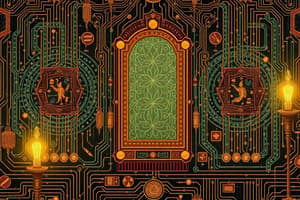Podcast
Questions and Answers
النظام الرقمي يعتمد على قيم متصلة
النظام الرقمي يعتمد على قيم متصلة
False (B)
نظام الأرقام الثنائي يستخدم عشر أرقام
نظام الأرقام الثنائي يستخدم عشر أرقام
False (B)
حاجزNOT يمكن أن يُنتج "1" كخروج من "0".
حاجزNOT يمكن أن يُنتج "1" كخروج من "0".
True (A)
الدوائر المنطقية التحويلية تتضمن عناصر تخزين الذاكرة
الدوائر المنطقية التحويلية تتضمن عناصر تخزين الذاكرة
تصميم الدوائر الرقمية يستلزم اختيار المكونات و تصميم الوصلات بينها
تصميم الدوائر الرقمية يستلزم اختيار المكونات و تصميم الوصلات بينها
Flashcards
النظام الرقمي
النظام الرقمي
يمثل المعلومات باستخدام قيم منفصلة، غالبًا 0 و 1.
الأنظمة العددية
الأنظمة العددية
تستخدم أنظمة عددية مختلفة مثل ثنائي، عشري، وثماني.
بوابات المنطق
بوابات المنطق
عناصر أساسية تنفذ عمليات منطقية على مدخلات ثنائية.
دوائر المنطق التتابعية
دوائر المنطق التتابعية
Signup and view all the flashcards
تصميم الدوائر الرقمية
تصميم الدوائر الرقمية
Signup and view all the flashcards
Study Notes
Introduction to Digital Systems
- Digital systems represent information using discrete values, typically 0 and 1, unlike analog systems that use continuous values.
- These discrete values are represented by binary digits (bits).
- Digital systems are more reliable and less susceptible to noise compared to analog systems.
- Digital systems can be easily programmed and controlled using software.
- Examples of digital systems include computers, smartphones, and digital watches.
Number Systems and Codes
- Binary number system utilizes only two digits, 0 and 1, to represent numbers.
- Decimal number system employs ten digits from 0 to 9.
- Octal and hexadecimal number systems are used in computer science to represent binary values more concisely.
- Conversion between different number systems is essential for working with digital systems.
Logic Gates
- Basic building blocks of digital circuits.
- Perform logical operations (AND, OR, NOT, XOR, NAND, NOR) on binary inputs to produce binary outputs.
- Each gate has a unique truth table describing its behavior.
- These gates can be combined to create complex logic circuits.
Combinational Logic Circuits
- Composed of interconnected logic gates with no memory elements.
- The output of the circuit depends solely on the current input values.
- Examples include decoders, encoders, multiplexers, and adders.
- Implement specific Boolean functions determined by the interconnections of gates.
Sequential Logic Circuits
- Include memory elements (flip-flops) that store previous inputs, altering their output based on both current and past inputs.
- Allow for sequential processing of data, enabling timing-dependent functions.
- Examples include counters, registers, and finite state machines.
- Used in applications requiring memory and timing capabilities.
Digital Circuit Design
- Design process involves defining the required functionality, choosing components (logic gates, flip-flops), and designing the interconnections.
- Design tools like schematic capture and simulation software aid the design process. These software tools allow for detailed modeling before physical implementation.
- Several design methodologies exist, ranging from simple logic gate designs to more complex sequential circuit implementations.
- Verification and testing are critical to ensuring that the circuit functions as intended.
Arithmetic Circuits
- Essential components in digital systems for performing arithmetic operations.
- Binary adders, subtractors, multipliers, and dividers are crucial for calculation in digital circuitry.
- Implementation of these circuits involves cascading logic gates and employing specific algorithms.
- Precision and speed are usually critical factors to consider in developing arithmetic circuits.
Memory Devices
- RAM (Random Access Memory) allows for fast access to stored data.
- ROM (Read-Only Memory) stores data permanently or with limited read-modify capability.
- Different types of memory (SRAM, DRAM, Flash) each come with distinct capabilities and tradeoffs in terms of speed, cost, and capacity.
- Crucial for storing programs and data in digital systems.
Digital System Applications
- Computers and smartphones leverage digital systems for processing information and performing various tasks.
- Various industries like telecommunications, automation, and industrial controls extensively use digital circuits.
- Applications range from data processing to communication and control systems in automated processes.
Digital System Advantages
- High accuracy in data representation.
- Increased reliability in comparison to analog systems.
- Ability to implement complex functionalities, owing to ease of programming.
- Easily programmable for new functions without changing hardware.
Digital System Limitations
- Limited precision compared to analog systems in some cases.
- Potential for rounding errors in numerical calculations, especially when dealing with very large or very small numbers.
- More complex to design intricate analog signals that precisely mimic environmental readings.
Studying That Suits You
Use AI to generate personalized quizzes and flashcards to suit your learning preferences.




